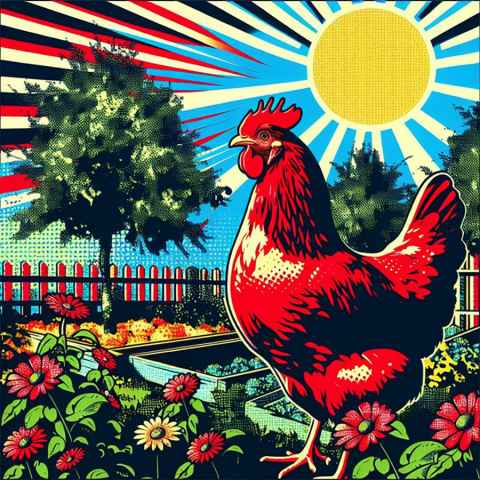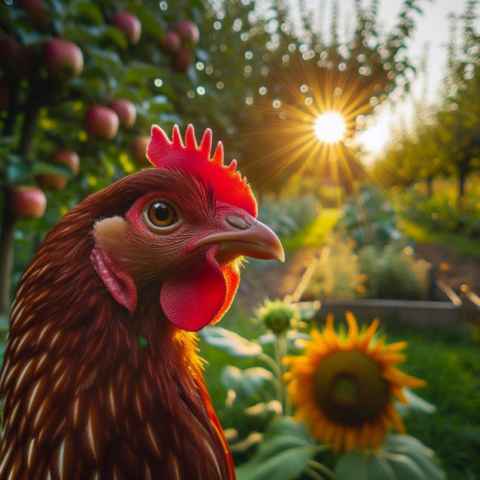AI, copyright and the image of a red chicken
15 August 2025
Analysis: Copyright is complicated, and artificial intelligence has made it even more so. Alex Sims explains with an image of a red chicken.

If you have the right tools, generative AI has made it easy to create high-quality images, simply through providing it with textual prompts – commonly called Text To Image. This raises numerous ethical and legal issues, including whether images generated this way are protected by copyright and who owns the copyright in those images.
The GenAI models – such as Midjourney, Gemini, and DALL-E 3 – are not creating works out of thin air. They rely on training data, which are often works found online and copied without the permission of the copyright owners. Artists and other creatives are understandably concerned about the copying of their works, and some are starting to sue the owners of these models for copyright infringement in the US, the EU, the UK, and elsewhere.
It may come as a surprise for readers that under copyright law if a GenAI image has drawn inspiration from hundreds or thousands of works but has not copied a substantial part of an identifiable work protected by copyright, the GenAI image will not infringe copyright.
Can the GenAI images that do not infringe copyright be protected by copyright? I investigated this question for an article in the New Zealand Business Law Quarterly. In the US and some other countries, the answer is currently no: GenAI images created with prompts are not protected by copyright. However, New Zealand’s copyright law is different. It may be possible for such works to be protected by copyright.
However, there is no automatic protection. The image must be “original”. Before looking at what “original” means in copyright law, another of copyright law’s oddities is that artists do not have copyright of their artistic style. For instance, if a user prompts a GenAI model to create a red chicken in the style of Roy Lichtenstein, if Lichtenstein did not create a similar red chicken in his distinctive style, there will be no copyright infringement.
You could demonstrate originality though, if you used skill and judgment in your prompt. Simple prompts such as “red chicken” or even “red chicken in a garden with the sun shining, with trees and flowers” would not show sufficient skill or judgment. But you might be able to get copyright of an image produced from detailed prompt such as the following:

You could demonstrate originality though, if you used skill and judgment in your prompt. Simple prompts such as “red chicken” or even “red chicken in a garden with the sun shining, with trees and flowers” would not show sufficient skill or judgment. But you might be able to get copyright of an image produced from detailed prompt such as the following:
“Create a close-up photograph of a red shaver chicken in profile view in a lush garden with the sun’s crepuscular rays showing, the chicken is centred in the image, to its right and slightly behind the chicken are apple trees, to its left and slightly behind the chicken are large sunflowers, the background is out of focus creating a bokeh effect, the overall appearance is interesting with detailed texture of the birds’ feathers, there is no text or additional objects in the image”.
(I wrote this prompt. The “bokeh effect” is a term in photography, which describes the aesthetic quality of the blur in the out-of-focus parts of an image.)
Alternatively, a work may be considered original if enough time and effort was spent in creating it. If a user created an image using GenAI and then spent a long time modifying that image through a series of prompts, that could make the image original and protected by copyright.

If an image is sufficiently original and therefore protected by copyright, who owns the copyright? The AI user or the owner of the GenAI model, or someone else? The answer depends on which country the user is attempting to claim copyright in. Under New Zealand’s Copyright Act, because the user provided the prompt (or prompts), the user is likely to be treated as the first owner of the copyright.
However, because GenAI images are treated as computer-generated works, these images won’t be protected to the same extent as more traditionally created works, such as a painting painted by an artist. The copyright in a traditional painting will last for 50 years after the artist’s death. In contrast, copyright in computer-generated works lasts for 50 years from the end of the year in which it was created.
Also, while painters will have moral rights in relation to their own painting, users do not gain moral rights of images created with AI. One type of moral right is the right of integrity, when artists can complain if a change to their work harms their reputation or integrity.
Another difference in the copyright of an original artwork, compared with an AI-created image, is that with the latter, the level of protection depends on the level of originality. The level of skill and judgment when using prompts is lower than that of an artist painting a painting; therefore, a person “copying” the GenAI image would have to copy the GenAI image almost exactly to infringe copyright. For the painting, infringement could occur if a substantial part had been copied, even if there were large differences.
Copyright is complicated, and AI makes it even more so. Because the level of protection for AI images will be lower than for traditional created works, I argue that GenAI images need to be marked as such and the Copyright Act 1994 amended so that the copyright owner of a GenAI image is unable to sue for copyright infringement if they have not sufficiently watermarked the image.
Dr Alex Sims is a professor in the Department of Commercial Law at the University of Auckland Business School.
This article reflects the opinion of the author and not necessarily the views of Waipapa Taumata Rau University of Auckland.
This article was first published on Newsroom, A copyright game of chicken, 15 August, 2025.
Media contact
Margo White I Research communications editor
Mob 021 926 408
Email margo.white@auckland.ac.nz